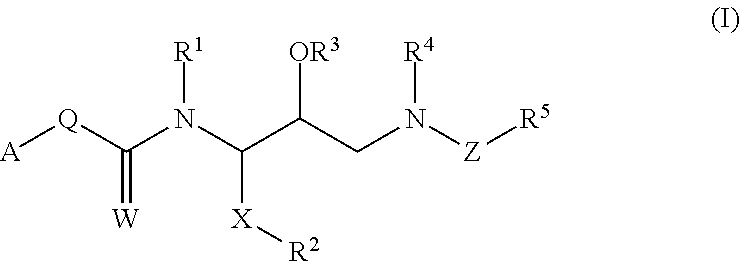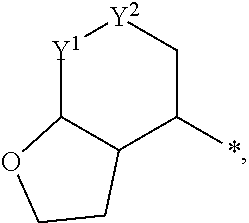Compounds and methods for treating HIV
a technology of compound and method, applied in the field of compound, can solve the problems of increasing the toxicity and complexity of these treatment regimens, exacerbate the limitation of antiviral therapy of aids, and eradicating human immunodeficiency virus type 1 (hiv 1) is currently unachievable, and achieves excellent activity, excellent enzyme inhibitory activity and antiviral potency
- Summary
- Abstract
- Description
- Claims
- Application Information
AI Technical Summary
Benefits of technology
Problems solved by technology
Method used
Image
Examples
examples a
Methods and Examples A
General Synthesis Example
[0479]The synthesis of enantiomerically pure (3aS,4S,7aR)-hexahydro-2H-furo[2,3-b]pyran-4-ol is shown in Scheme 1. It was achieved starting from known enantiomerically pure lactone 4.27 Lactone 4 was reduced into the corresponding diol using lithium aluminum hydride in 95% yield. Selective monoacetylation at the primary alcohol using AcCl and 2,4,6-collidine at −78° C.,28 and subsequent silylation of the remaining free hydroxyl furnished intermediate 5 in 86% yield (2 steps). Removal of the acetate group, followed by ozonolysis of the olefin, furnished a bicyclic bis-acetal intermediate. Reduction of the hemiacetal moiety using Et3SiH and BF3-Et2O afforded bicyclic intermediate 6 in 55% yield in three steps. Removal of the silyl group with TBAF in THF furnished the desired hexahydrofuropyran-4-ol ligand (−)-7.
[0480]To demonstrate the importance of the absolute stereochemistry of the bicyclic structure of ligand (−)-7, its corresponding ...
example a1
General Experimental Methods
[0486]All anhydrous solvents were obtained according to the following procedures: diethyl ether and tetrahydrofuran (THF) were distilled from sodium / benzophenone under argon; toluene, methanol, acetonitrile, and dichloromethane from calcium hydride and benzene from sodium. Other solvents were used without purification. All moisture-sensitive reactions were carried out in flame-dried flasks under argon atmosphere. Reactions were monitored by thin layer chromatography (TLC) using Silicycle 60A-F254 silica gel pre-coated plates. Flash column chromatography was performed using Silicycle 230-400 mesh silica gel. Yields refer to chromatographically and spectroscopically pure compounds. Optical rotations were recorded on a Perkin Elmer 341 polarimeter. 1H NMR and 13C NMR spectra were recorded on a Varian Inova-300 (300 and 75 MHz), Bruker Avance ARX-400 (400 and 100 MHz) or DRX-500 (500 and 125 MHz). High and low resolution mass spectra were carried out by the M...
example a2
[0487](1S,2R)-2-[1-(tert-Butyldimethylsilyloxy)-cyclopent-3-en-2-yl]ethyl acetate (5). To a stirred suspension of lithium aluminum hydride (93 mg, 2.45 mmol) in dry Et2O (6 mL) was added dropwise a solution of (−)-(1S,5R)-2-oxabicyclo[3.3.0]oct-6-en-3-one (4) (150 mg, 1.19 mmol) in Et2O (4 mL+1 mL rinse) at 0° C. under argon. The reaction mixture was vigorously stirred at this temperature for 1.5 h. Water (0.1 mL) was then carefully added followed by addition of 3M NaOH (0.1 mL) then water (0.3 mL). The solution was stirred until formation of a white precipitate was complete. EtOAc (3 mL) then Na2SO4 were added and the resulting suspension was filtered out. The amorphous solid was washed several time with EtOAc (5×5 mL). The combined organic layers were dried over Na2SO4, filtered, and concentrated in vacuo. The crude oil was purified by flash chromatography on silica gel using hexanes / EtOAc (1:1) as the eluent to give the resulting diol (145 mg, 95%) as a colorless oil. TLC: Rf=0.2...
PUM
| Property | Measurement | Unit |
|---|---|---|
| enantiomeric excess | aaaaa | aaaaa |
| temperature | aaaaa | aaaaa |
| temperature | aaaaa | aaaaa |
Abstract
Description
Claims
Application Information
 Login to View More
Login to View More - R&D
- Intellectual Property
- Life Sciences
- Materials
- Tech Scout
- Unparalleled Data Quality
- Higher Quality Content
- 60% Fewer Hallucinations
Browse by: Latest US Patents, China's latest patents, Technical Efficacy Thesaurus, Application Domain, Technology Topic, Popular Technical Reports.
© 2025 PatSnap. All rights reserved.Legal|Privacy policy|Modern Slavery Act Transparency Statement|Sitemap|About US| Contact US: help@patsnap.com



